Download 1238100000 Transclinic 4i+ 1238110000 Transclinic 7i+
Transcript
1238100000 Transclinic 4i+ 1238110000 Transclinic 7i+ 1238120000 Transclinic 8i+ 1238130000 Transclinic 14i+ ES Manual de instrucciones IT Manuale d’istruzioni 15 FR Manuel d’instructions 27 PT Manual de instruções 39 EN Instruction manual 51 DE Bedienungsanleitung 63 3 2 ES Manual de instrucciones 1. 2. 3. 4. 5. 6. 7. 8. 9. 10. 11. 12. 13. 14. 15. Histórico de revisiones Empleo reglamentario Personal especializado Corrección de la documentación técnica Norma CE Declaración de conformidad Reciclaje según WEEE Uso Especificaciones Diagrama de conexionado Conexión Configuración Instalación eléctrica Comportamiento de temperatura Instrucciones de seguridad y advertencias 4 4 4 5 5 5 5 6 6 7 8 9 11 13 13 Edición de mayo de 2011 3 ES 1. Histórico de revisiones Versión Fecha Modificación 02 05/11 2ª edición 2. Empleo reglamentario AVISO El aparato ha sido concebido exclusivamente para las aplicaciones descritas en las instrucciones. Un empleo diferente al indicado no está permitido y puede dar lugar a accidentes o a la destrucción del aparato. Un empleo tal tiene como consecuencia la extinción inmediata de la garantía y la nulidad de todos los derechos del usuario frente al fabricante. Durante el manejo y el montaje de aparatos ESD hay que tener en cuenta las medidas de protección. ADVERTENCIA: Zona de peligro El empleo del producto seleccionado al margen de las especificaciones o sin tener en cuenta las indicaciones de manejo y de advertencia puede dar lugar a disfunciones graves, como consecuencia de las cuales pueden producirse también daños personales y materiales. 3. Personal especializado Estas instrucciones están dirigidas a profesionales debidamente formados que conocen bien las prescripciones y normas vigentes del campo de aplicación correspondiente. 4. Corrección de la documentación técnica Estas instrucciones de manejo han sido preparadas con gran cuidado y meticulosidad. No asumimos garantía alguna o responsabilidad por la corrección y completitud de los datos, figuras y dibujos, a no ser que esté prescrita por la legislación vigente. Rigen las condiciones generales de venta de Weidmüller en la versión válida en cada caso. Sujeto a modificaciones. 4 ES 5. Norma CE El producto satisface las directivas de la Unión Europea (UE) y está por ello en conformidad con la CE. 6. Declaración de conformidad El producto cumple la directiva de baja tensión 2006/95/CE, la directiva de compatibilidad electromagnética 2004/108/CE y la directiva de seguridad del producto 01/95/CE (DIN EN 61010-1) 7. Reciclaje según WEEE Con la adquisición de nuestro producto dispone usted de la posibilidad de devolvérselo a Weidmüller una vez que haya transcurrido su ciclo de vida La WEEE (directiva comunitaria 2002/ 96 CE) regula la recogida y el reciclaje de aparatos eléctricos usados. Los fabricantes de aparatos eléctricos están obligados a partir de 13.8.2005 a recoger y a reciclar gratis todos los aparatos vendidos a partir de esa misma fecha. Ya no se permite eliminar los aparatos eléctricos por los cauces „normales“ de eliminación de desechos. Los aparatos eléctricos y electrónicos tienen que reciclarse y eliminarse por separado. Todos los aparatos sujetos a esta directiva están caracterizados con este logotipo: ¿Qué podemos hacer por usted? Weidmüller le ofrece la posibilidad de que nos entregue sin costos su aparato usado. Weidmüller reciclará y eliminará el aparato profesionalmente en conformidad con la legislación actual. ¿Qué ha de hacer usted? Después de que su aparato haya llegado al final de su vida útil, enviéselo por correo (dentro de una caja) a la filial de Weidmüller que le asesora: nosotros nos hacemos entonces cargo de todas las medidas de reciclaje y de eliminación. El proceso es para usted libre de costos y de molestias. 5 ES 8. Uso Los Transclinic son equipos para la monitorización remota de tensión y corriente, captan los valores provenientes de los strings del campo fotovoltaico. Los valores medidos son accesibles a través de un “host” vía MODBUS. 9. Especificaciones Especificaciones técnicas según tabla: Máximo número de strings Transclinic 7i+ Transclinic 8i+ Transclinic 14i+ 4 7 8 14 Máxima corriente por string 30 A DC 20 A DC 30 A DC 20 A DC Rango de medida 3..30 A DC 3..20 A DC 3..30 A DC 3..20 A DC Máxima Tensión 1000 V DC 1000 V DC 1000 V DC 1000 V DC Tensión de alimentación 19 - 36 V DC 19 - 36 V DC 19 - 36 V DC 19 - 36 V DC Rango de temperatura -20 ... +70 °C -20 ... +70 °C -20 ... +70 °C -20 ... +70 °C Comunicación MODBUS RS485 RTU MODBUS RS485 RTU MODBUS RS485 RTU MODBUS RS485 RTU Entrada analógica 0 ... +10 V o 0 ... 20 mA 0 ... +10 V o 0 ... 20 mA 0 ... +10 V o 0 ... 20 mA 0 ... +10 V o 0 ... 20 mA Número de entradas analógicas 2 2 2 2 0 ... 5 V low, 15 ... 24 V high 0 ... 5 V low, 15 ... 24 V high 0 ... 5 V low, 15 ... 24 V high 0 ... 5 V low, 15 ... 24 V high Entrada digital Número de entradas digitales Salida digital Número de salidas digitales 1 1 1 1 max 30 V DC/AC 50 mA max 30 V DC/AC 50 mA max 30 V DC/AC 50 mA max 30 V DC/AC 50 mA 1 1 1 1 Consumo de potencia < 1500 mW < 1500 mW < 1500 mW < 1500 mW Dimensiones 225 x 109.5 x 92.2 265 x 109.5 x 92.2 295 x 109.5 x 92.2 370 x 109.5 x 92.2 ± 1% ± 1% ± 1% ± 1% Máximo error de lectura 6 Transclinic 4i+ ES 10. Diagrama de conexionado PV PANEL Placa de potencia S2 X4 S3 + + – S4 Input DC– S5 X2 S6 X1 S7 Output DC– S8 S1 TRANSCLINIC XI+ g 485+ Modbus RS485 RTU X7 Power Supply 18...36 VDC X6 Analoge input X5 Analoge input X8 Digital input X4 Digital output GND 485 485+ 485– g Modbus RS485 RTU X3 Modbus X1 485– GND 485 24 V 0V Placa CPU VIN IIN GND VIN IIN GND IN1+ + SW2 INVERTER IN2– – IN2+ SW1 IN1– 7 ES 11. Conexión La conexión/desconexión eléctrica sólo debe ser realizada por personal técnico cualificado, donde deben asegurarse los siguientes puntos: Antes de la instalación/desinstalación del equipo hay que asegurarse de que no exista tensión en ningún punto de la carcasa. n Debe usarse un destornillador con el ancho de pala adecuado. n Los cables de conexión deben fijarse firmemente y sin carga de tracción. Alimentación. 24 V DC con una fuente de alimentación conmutada y con aislamiento galvánico, en el conector X7, según esquema. Debe utilizarse un fusible externo: Weidmüller WSI4 (1886580000), 5x20mm, de acción lenta. Comunicación. Cableado de la línea Modbus en los conectores X1 y X3. Entradas digitales opto-acopladas. Conector X8, entradas activas a niveles entre 15 V DC y 24 V DC. Se aconseja utilizar F.A. conmutada y con aislamiento galvánico. Medida intensidades de entrada. Conectar el polo negativo de la conexión en serie de los paneles fotovoltaicos a los bornes X1 (en todas las versiones) y X4 (existente sólo en TRANSCLINIC 8i+ y 14i+). En caso de disponer de entrada X4, se recomienda balancear las cargas entre las dos entradas de forma uniforme. Salida común medida intensidades. Las conexiones comunes de las corrientes de salida se conectan a la(s) barra(s) conductora(s) en la placa de circuitos. Al conectar la conexión común de los polos negativos, asegúrese del correcto par de apriete de cada uno de los espárragos, independientemente de si hay un cable conectado o no. Cablear siempre las pletinas de salida cuyos bornes de entrada estén conectados. Medida de tensión. Conectar el polo positivo de la cadena de paneles al conector X2. Si únicamente se quiere medir la tensión de la serie de paneles, sin conectar una entrada o salida de corriente, conectar el polo negativo al conector X2. En cualquier otro caso, el polo negativo de la medición de tensión en X2 ya está conectado con el polo negativo de la cadena de paneles, por lo que no debe conectarse. 8 ES 12. Configuración Mediante los interruptores SW1 y SW2 se configuran los siguientes parámetros. SW1 Dirección de MODBUS según la tabla siguiente. SW1.8 OFF SW1.7 OFF SW1.6 OFF SW1.5 OFF SW1.4 OFF SW1.3 OFF SW1.2 OFF SW1.1 ON ID 1 OFF OFF OFF OFF OFF OFF OFF OFF OFF OFF OFF ON ON OFF OFF OFF 2 4 OFF OFF OFF OFF ON OFF OFF OFF 8 OFF OFF OFF OFF OFF ON OFF ON OFF ON OFF OFF OFF OFF OFF OFF OFF OFF OFF OFF OFF OFF OFF OFF 16 32 64 ON OFF OFF OFF OFF OFF OFF OFF 128 9 ES SW2 Velocidad de transmisión de datos. Protección contra escritura de la memoria interna y bit de paridad. SW2.1 ON OFF Velocidad TX/RX 9600 bps 19200 bps SW2.2 ON Estado de memoria Memoria protegida OFF Memoria no protegida SW2.3 ON OFF SW2.4 10 Paridad EVEN NONE sólo para uso interno ES 13. Instalación eléctrica La instalación eléctrica debe realizarse por personal técnico cualificado, conforme a la normativa general de electrotecnia y cumpliendo con la normativa vigente. Asimismo deben cumplirse las normas específicas regionales. Estas abarcan, en particular, la correcta ejecución técnica: Para la protección frente a electrocuciones, los equipos deben ir instalados en envolventes o cuadros eléctricos que cumplan los siguientes requisitos: n Durante el manejo y el montaje de aparatos ESD hay que tener en cuenta las medidas de protección. n Regleta de montaje TS35 n La temperatura de instalación debe ser 10...40° C. n Disponer de un dispositivo de conmutación o desconexión para desconectar los circuitos de alimentación y altas tensiones. n El negativo del conector X2 está conectado eléctricamente al común de los negativos, en la pletina de corriente, por lo que el no conexionado de este no afecta a la medida. Bajo ningún concepto debe conectarse a ningún otro negativo del equipo. El conexionado del negativo de cualquiera de los Strings a este punto (negativo de X2), dañaría el equipo. n El correcto dimensionado del cableado y demás dispositivos. n Se aconseja el uso de cable apantallado para las comunicaciones. Cable de bus recomendado: cable Lapp UNITRONIC BUS LD 2x2x0,22 (ref.: 2170204). n Los cables de conexión se asientan firmemente y son de la sección adecuada. 11 ES n Sección embornable y par de apriete de los diferentes conectores: X1, X4 Conexiones de string para medir la corriente (Entrada CC en placa de potencia) n C on terminales de cable de 0,5 a 10 mm2 o sin terminal de cable de 0,5 a 16 mm2. n Par de apriete 1.2-1.5 Nm. n Longitud de aislamiento / medida de hoja: 12 mm / 1,0 x 5,5 X2 (en placa de potencia): n C on terminales de cable de 0,5 a 10 mm² o sin terminal de cable de 0,5 a 16 mm². n Par de apriete 1.2-1.5 Nm. n Longitud de aislamiento / medida de hoja: 12 mm / 1,0 x 5,5 X1, X3, X5, X6, X7, X8 (en placa CPU): n C on terminales de cable de 0,2 a 2,5 mm² o sin terminal de cable de 0,2 a 4 mm². n Par de apriete 0.4-0.5 Nm. n Longitud de aislamiento / medida de hoja: 7 mm / 0,6 x 3,5 Barra conductora (Salida CC – en placa de potencia): n Cable con empalmador de cable colectivo M6. Se recomienda el artículo 4R6 de la empresa Klauke (25 mm²). n Par de apriete 4-4.5 Nm. n En los aparatos Transclinic 8i+ y 14i+ debe conectarse en ambas barras conductoras el mismo número de strings de paneles fotovoltaicos para medir la corriente. Debe conectarse como mínimo un string de panel fotovoltaicos por barra conductora. n El emplazamiento final del equipo debe asegurar el aislamiento y la protec- ción contra el fuego, así como una resistencia mecánica suficiente según la norma UNE-EN 60439-1. 12 ES Protección contra la sobretensión: La protección contra la sobretensión de Transclinic xi+ debe garantizarse mediante una instalación adicional de una protección contra la sobretensión externa. Deben usarse cables con la misma sección transversal para conectar a tierra la conexión. Para los strings debe usarse el artículo Weidmüller 8882350001. Para la comunicación RS485 debe usarse el artículo Weidmüller 8924270000 (zócalo) y 8924670000 (pieza insertada). Para el suministro de corriente debe usarse el artículo Weidmüller 8860360000. No se permite ninguna corriente de fuga contra potencial de tierra. 14. Comportamiento de temperatura El módulo está diseñado para poder trabajar dentro de un rango de temperatura extendido de -20 °C a +70 °C. 15. Instrucciones de seguridad y advertencias Este equipo está previsto exclusivamente para las aplicaciones descritas en el manual de operación. Está catalogado como categoría I y por tanto no deberá utilizarse para la medida en otras categorías. Cualquier otro uso se considera como un uso indebido, que podría llegara a causar accidentes y daños irreversibles pudiendo llegar a la destrucción del propio equipo. El uso indebido provocará la anulación inmediata de cualquier tipo de reclamación de garantía por parte del usuario frente al fabricante. 13 14 IT Manuale d’istruzioni 1. 2. 3. 4. 5. 6. 7. 8. 9. 10. 11. 12. 13. 14. 15. Cronologica delle revisioni Utilizzo conforme alla finalità d’uso Personale tecnico Correttezza della documentazione tecnica Marcatura CE Dichiarazione di conformità Riciclaggio secondo WEEE Uso Specifiche tecniche Schema elettrico Collegamenti Configurazione Impianto elettrico Comportamento termico Istruzioni di sicurezza e avvertenze 16 16 16 16 17 17 17 18 18 19 20 21 23 25 25 Edizione maggio 2011 15 IT 1. Cronologica delle revisioni Versione Data Modifiche 02 05/11 2a edizione 2. Utilizzo conforme alla finalità d’uso AVVISO L’apparecchio è progettato esclusiva-mente per le applicazioni descritte nelle presenti istruzioni per l’uso. Un impiego diverso è da considerarsi inammissibile e potrebbe provocare incidenti o la distruzione dell’apparecchio. Tali utilizzi comportano l’immediato annullamento dei diritti di garanzia da parte dell’utente nei confronti del produttore. Durante l’utilizzo e il montaggio degli apparecchi, prestare attenzione alle misure di sicurezza ESD prescritte. AVVERTENZA: Punto pericoloso Un utilizzo del prodotto che non rientri nelle specifiche prescritte ovvero la mancata osservanza delle istruzioni e degli avvertimenti potrebbero causare malfunzionamenti con la conseguente possibilità di danni a persone e cose. 3. Personale tecnico Le presenti istruzioni per l’uso sono destinate a tecnici specializzati che abbiano acquisito familiarità con le norme e le disposizioni in vigore nel settore in cui operano. 4. Correttezza della documentazione tecnica Le presenti istruzioni per l‘uso sono state redatte con estrema cura. Si declina ogni responsabilità per la correttezza e la completezza di dati, figure e disegni, a meno che questo non sia previsto per legge. Sono valide le condizioni di acquisto generali di Weidmüller nella versione di volta in volta applicabile. Con riserva di modifiche. 16 IT 5. Marcatura CE Il prodotto soddisfa le direttive dell’Unione Europea (UE), risultando pertanto conforme alla norma CE. 6. Dichiarazione di conformità Il prodotto soddisfa le direttive sulla bassa tensione 2006/95/CE, la direttiva EMC 2004/108/CE e la direttiva sulla sicurezza dei prodotti 01/95/CE (DIN EN 61010-1). 7. Riciclaggio secondo WEEE Con l’acquisto di questo prodotto, Lei avrà la possibilità di riconsegnare l’apparecchio a Weidmüller alla fine del suo ciclo di vita. La WEEE (direttiva europea 2002/96 CE) regola la restituzione e il riciclaggio degli apparecchi elettrici. I produttori di apparecchi elettrici sono obbligati, a partire dal 13.8.2005, a ritirare e riciclare gratuitamente gli apparecchi elettrici acquistati dopo tale data. Pertanto gli apparecchi elettrici non devono più essere smaltiti tra i rifiuti „normali“. Gli apparecchi elettrici devono essere riciclati e smaltiti separatamente. Tutti gli apparecchi che rientrano in questa direttiva sono contrassegnati con questo logo. Che cosa possiamo fare per lei? Weidmüller le offre pertanto una possibilità di restituzione gratuita del Suo vecchio apparecchio. Weidmüller si farà carico del corretto riciclaggio e smaltimento del Suo apparecchio secondo quanto previsto dalla normativa corrente. Che cosa deve fare lei? Una volta che l’apparecchio ha completato il proprio ciclo di vita, lo invii semplicemente tramite corriere (in una scatola) all’affiliata Weidmüller di riferimento. Provvederemo noi ad adottare le appropriate misure di riciclaggio e smaltimento. Senza costi né complicazioni da parte Sua. 17 IT 8. Uso I Transclinic sono dei dispositivi che consentono di monitorare a distanza la tensione e la corrente, rilevando i valori provenienti dalle stringhe di un campo fotovoltaico. I valori misurati sono accessibili tramite un host via MODBUS. 9. Specifiche tecniche Specifiche tecniche secondo la tabella: Nº massimo di stringhe Corrente massima per stringa Intervallo di misurazione Tensione massima Tensione di alimentazione Range di temperatura Comunicazione Ingresso analogico Numero di ingressi analogici Ingresso digitale Numero di ingressi digitali Uscita digitale Numero di uscite digitali Potenza assorbita Ingombro Errore di misura max. 18 Transclinic 4i+ Transclinic 7i+ Transclinic 8i+ Transclinic 14i+ 4 7 8 14 30 A DC 20 A DC 30 A DC 20 A DC 3..30 A DC 3..20 A DC 3..30 A DC 3..20 A DC 1000 V DC 1000 V DC 1000 V DC 1000 V DC 19 - 36 V DC 19 - 36 V DC 19 - 36 V DC 19 - 36 V DC -20 ... +70 °C -20 ... +70 °C -20 ... +70 °C -20 ... +70 °C MODBUS RS485 RTU MODBUS RS485 RTU MODBUS RS485 RTU MODBUS RS485 RTU 0 ... +10 V o 0 ... 20 mA 0 ... +10 V o 0 ... 20 mA 0 ... +10 V o 0 ... 20 mA 0 ... +10 V o 0 ... 20 mA 2 2 2 2 0 ... 5 V low, 15 ... 24 V high 0 ... 5 V low, 15 ... 24 V high 0 ... 5 V low, 15 ... 24 V high 0 ... 5 V low, 15 ... 24 V high 1 1 1 1 max 30 V DC/AC 50 mA max 30 V DC/AC 50 mA max 30 V DC/AC 50 mA max 30 V DC/AC 50 mA 1 1 1 1 < 1500 mW < 1500 mW < 1500 mW < 1500 mW 225 x 109.5 x 92.2 265 x 109.5 x 92.2 295 x 109.5 x 92.2 370 x 109.5 x 92.2 ± 1% ± 1% ± 1% ± 1% IT 10. Schema elettrico PV PANEL Scheda di potenza S2 X4 S3 + + – S4 Input DC– S5 X2 S6 X1 S7 Output DC– S8 S1 TRANSCLINIC XI+ g 485+ Modbus RS485 RTU X7 Power Supply 18...36 VDC X6 Analoge input X5 Analoge input X8 Digital input X4 Digital output GND 485 485+ 485– g Modbus RS485 RTU X3 Modbus X1 485– GND 485 24 V 0V Scheda CPU VIN IIN GND VIN IIN GND IN1+ + SW2 INVERTER IN2– – IN2+ SW1 IN1– 19 IT 11. Collegamenti Il collegamento/scollegamento elettrico può essere effettuato solo da personale tecnico qualificato, garantendo sempre i seguenti punti: Prima dell’installazione/disinstallazione dell’impianto, assicurarsi che tutti i punti della custodia siano privi di tensione. n Utilizzare un cacciavite con una lama di dimensioni adeguate. n I cavi di collegamento devono essere fissati al punto fisso e al punto mobile. Alimentazione. 24 V DC con alimentatore commutato e isolamento galvanico, nel connettore X7, secondo lo schema. Utilizzare un fusibile esterno: Weidmüller WSI4 (1886580000), 5x20mm, lento. Comunicazione. Cablaggio della linea Modbus nei connettori X1 e X3. Ingressi digitali optoaccoppiati. Connettore X8, ingressi attivi a livelli compresi tra 15 V DC e 24 V DC. Si consiglia di utilizzare un alimentatore switching con isolamento galvanico. Misurazione delle correnti di ingresso. Collegare il polo negativo del collegamento in serie dei pannelli fotovoltaici ai morsetti X1 (in tutti i modelli) e X4 (presente solo in TRANSCLINIC 8i+ e 14i+). Se l’ingresso X4 è disponibile, si consiglia di ripartire uniformemente i carichi tra i due ingressi. Uscita comune per la misurazione di correnti. Collegare i cavi comuni delle correnti di uscita alle barre di corrente sul circuito stampato. In caso di allacciamento del collegamento comune dei poli negativi, verificare la corretta coppia di serraggio di ogni singolo perno, indipendentemente se il cavo è collegato o meno. Cablare sempre le barre di corrente di uscita che hanno i morsetti di ingresso collegati. Misurazione della tensione. Collegare il polo positivo della stringa fotovoltaica al collegamento X2. Per misurare la tensione della stringa fotovoltaica senza collegare un ingresso o un’uscita elettrica, collegare il polo negativo al collegamento X2. In tutti gli altri casi, collegare il polo negativo della misurazione della tensione di X2 al polo negativo della stringa fotovoltaica, senza collegare quest’ultima. 20 IT 12. Configurazione Gli switch SW1 e SW2 consentono di configurare i seguenti parametri. SW1 Indirizzo del MODBUS, secondo la tabella seguente. SW1.8 OFF SW1.7 OFF SW1.6 OFF SW1.5 OFF SW1.4 OFF SW1.3 OFF SW1.2 OFF SW1.1 ON ID 1 OFF OFF OFF OFF OFF OFF OFF OFF OFF OFF OFF ON ON OFF OFF OFF 2 4 OFF OFF OFF OFF ON OFF OFF OFF 8 OFF OFF OFF OFF OFF ON OFF ON OFF ON OFF OFF OFF OFF OFF OFF OFF OFF OFF OFF OFF OFF OFF OFF 16 32 64 ON OFF OFF OFF OFF OFF OFF OFF 128 21 IT SW2 Velocità di trasmissione dei dati. Protezione contro la scrittura della memoria interna e bit di controllo di parità. SW2.1 ON OFF Velocità TX/RX 9600 bps 19200 bps SW2.2 ON Stato della memoria Memoria protetta OFF Memoria non protetta SW2.3 ON Parità EVEN OFF NONE SW2.4 22 Solo per uso interno IT 13. Impianto elettrico L’impianto elettrico deve essere eseguito da personale tecnico qualificato, ai sensi delle norme generali in materia di elettrotecnica e in conformità alla normativa vigente. Inoltre occorre attenersi alle norme specifiche regionali, che descrivono in particolare la corretta esecuzione tecnica: Per poter garantire una protezione contro i contatti accidentali, è necessario installare i dispositivi in apposite custodie o quadri elettrici che soddisfino i seguenti requisiti: n Durante l’utilizzo e il montaggio degli apparecchi, prestare attenzione alle misure di sicurezza ESD prescritte. n Guida TS35 n La temperatura di installazione è di 10...40° C. n Siano muniti di un dispositivo di commutazione o disinnesto per scollegare i circuiti di alimentazione e le alte tensioni. n Il negativo del connettore X2 è collegato elettricamente al comune dei negativi nella barra di corrente. Di conseguenza, il collegamento di questo cavo non incide sulla misurazione. In nessun caso collegarlo ad altri negativi del dispositivo. Collegando il negativo di qualsiasi stringa a questo punto (negativo di X2) si potrebbe danneggiare il dispositivo. n Un corretto dimensionamento del cablaggio e degli altri dispositivi. n Per le comunicazioni si consiglia di utilizzare un cavo schermato. Cavi bus consigliati: cavi Lapp UNITRONIC BUS LD 2x2x0,22 (Art.: 2170204). n I cavi di collegamento siano stati posati correttamente e la loro sezione sia adeguata. 23 IT n Rispettare campo di sezione e coppia di serraggio dei diversi connettori: X1, X4 Collegamenti della stringa alla misurazione di correnti (Input DC sulla scheda di potenza): n Con terminali da 0,5 a 10 mm² o senza terminali da 0,5 a 16 mm². n Coppia di serraggio 1,2-1.5 Nm. n Lunghezza di isolamento/Dimensioni lama: 12 mm / 1,0 x 5,5 X2 (sulla scheda di potenza): n Con terminali da 0,5 a 10 mm² o senza terminali da 0,5 a 16 mm². n Coppia di serraggio 1,2-1.5 Nm. n Lunghezza di isolamento/Dimensioni lama: 12 mm / 1,0 x 5,5 X1, X3, X5, X6, X7, X8 (sulla scheda CPU): n Con terminali da 0,2 a 2,5 mm² o senza terminali da 0,2 a 4 mm². n Coppia di serraggio 0,4-0.5 Nm. n Lunghezza di isolamento/Dimensioni lama: 7 mm / 0,6 x 3,5 Barra di corrente (Output DC sulla scheda di potenza): n Cavo con terminali ad anello M6. Si consiglia l‘articolo 4R6 della ditta Klauke (25 mm²). n Coppia di serraggio 4-4.5 Nm. n Nel caso dei dispositivi Transclinic 8i+ e 14i+, è necessario collegare sulle due barre di corrente lo stesso numero di stringhe fotovoltaiche per la misurazio ne di correnti. È necessario collegare almeno una stringa fotovoltaica per ogni barra di corrente. n L’ubicazione finale del dispositivo deve offrire una protezione antincendio nonché una certa resistenza meccanica, ai sensi della norma UNE-EN 60439-1. 24 IT Protezione contro le sovratensioni: La protezione contro le sovratensioni di Transclinic xi+ deve essere garantita tramite l’installazione supplementare di una protezione contro le sovratensioni esterna. In questo caso utilizzare cavi con la stessa sezione per stabilire un collegamento a massa. Per le stringhe, utilizzare l‘articolo 8882350001 di Weidmüller. Per la comunicazione RS485, utilizzare l’articolo Weidmüller 8924270000 (zoccolo) e 8924670000 (inserto). Per l’alimentazione di tensione, utilizzare l‘articolo 8860360000 di Weidmüller. Non è consentita alcuna corrente di dispersione contro il potenziale di terra. 14. Comportamento termico Il modulo è stato concepito per il funzionamento in un ampio campo di temperature, da -20 °C a +70 °C. 15. Istruzioni di sicurezza e avvertenze Questo dispositivo è stato concepito esclusivamente per gli utilizzi descritti nel manuale operativo. Essendo classificato come dispositivo di Classe I, non può essere utilizzato per effettuare misurazioni in altre categorie. Qualsiasi altro uso è considerato illecito, in quanto potrebbe provocare incidenti e danni irreversibili che porterebbero alla la distruzione del dispositivo stesso. In caso di utilizzi non ammessi dal manuale, l’utente non ha alcun diritto di pretendere dal produttore prestazioni in garanzia. 25 26 FR Manuel d’instructions 1. 2. 3. 4. 5. 6. 7. 8. 9. 10. 11. 12. 13. 14. 17. Révision Conformité d’utilisation Personnel qualifié Conformité de la documentation technique Marquage CE Déclaration de conformité Recyclage selon DEEE Utilisation Caractéristiques Schéma de câblage Connexion Configuration Installation électrique Température de fonctionnement Instructions de sécurité et avertissements 28 28 28 28 29 29 29 30 30 31 32 33 35 37 37 Édition du mai 2011 27 FR 1. Révision Version Date Modification 02 05/11 2ème édition 2. Conformité d’utilisation AVIS L’équipement n’est destiné qu’aux applications décrites dans le mode d’emploi. Toute autre utilisation est interdite et peut conduire à des accidents ou à la destruction de l’appareil. Ce type d’utilisation annule tout recours en garantie de l’utilisateur vis-à-vis du fabricant. Lors de la manipulation et du montage des appareils à décharge électrostatique, tenir compte des mesures de protection. AVERTISSEMENT ! Danger L’utilisation du produit sélectionné en dehors de la spécification ainsi que le non-respect des instructions d’utilisation et des avertissements peut provoquer de graves dysfonctionnements pouvant conduire à des dommages corporels ou matériels. 3. Personnel qualifié Le présent mode d’emploi est destiné à un personnel qualifié formé aux directives en vigueur ainsi qu’aux normes du domaine d’application. 4. Conformité de la documentation technique Nous n‘assumons aucune responsabilité ni garantie quant à l‘exactitude et à l‘intégralité des données, figures et dessins, pour autant qu‘elle ne soit prescrite légalement. Les conditions générales de vente de Weidmüller sont applicables dans leur version respective. Sous réserve de modifications. 28 FR 5. Marquage CE Le produit répond aux directives de la communauté européenne (EU) et est donc conforme CE. 6. Déclaration de conformité Ce produit respecte la directive basse tension 2006/95/CE, la directive CEM 2004/108/CE et la directive sur la sécurité produit 01/95/CE (NF EN 61010-1). 7. Recyclage selon DEEE En achetant notre produit, vous avez la possibilité de rendre l’appareil à Weidmüller au terme de son cycle de vie. La directive DEEE (directive UE 2002/96 CE) règlemente la récupération et le recyclage des appareils électriques anciens. Les fabricants d’appareils électriques sont tenus depuis le 13/08/2005 de reprendre gratuitement les appareils électriques vendus après cette date et de les recycler. Les appareils électriques ne doivent alors plus être mis aux déchets « normaux ». Les appareils électriques doivent être recyclés et mis aux déchets séparément. Tous les appareils con-cernés par cette directive portent ce logo. Que pouvons-nous faire pour vous ? Weidmüller vous offre donc une possibilité neutre en terme de coûts de nous retourner votre ancien appareil. Weidmüller recyclera et mettra alors aux déchets votre appareil conformément à la législation en vigueur. Que devez-vous faire ? Lorsque votre appareil est en fin de vie, mettez-le dans un carton et envoyez-le à la filiale Weidmüller qui s’occupe de vous. Nous nous chargerons en-suite de toutes les procédures de recyclage et de mise aux déchets. Ce service ne vous occasionnera aucun frais ni aucun inconvénient. 29 FR 8. Utilisation Les appareils Transclinic sont conçus pour surveiller à distance la tension et le courant. Ils saisissent les valeurs qui proviennent des chaînes du champ photovoltaïque, ainsi que l’état de 2 signaux tout ou rien issus du parafoudre (état de fonctionnement) du cofret DC et/ou d’un signal au choix de l’utilisateur (ouverture de porte, alarme de vol...). Les valeurs moyennes sont accessibles par l’intermédiaire d’un “serveur” via MODBUS. 9. Caractéristiques Caractéristiques techniques conformément au tableau: Nombre maximum de chaînes Courant maximum par chaîne Plage de mesure Transclinic 4i+ Transclinic 7i+ Transclinic 8i+ Transclinic 14i+ 4 7 8 14 30 A DC 20 A DC 30 A DC 20 A DC 3..30 A DC 3..20 A DC 3..30 A DC 3..20 A DC Tension maximale 1000 V DC 1000 V DC 1000 V DC 1000 V DC Tension d‘alimentation 19 - 36 V DC 19 - 36 V DC 19 - 36 V DC 19 - 36 V DC Température de fonctionnement -20 ... +70 °C -20 ... +70 °C -20 ... +70 °C -20 ... +70 °C Communication MODBUS RS485 RTU MODBUS RS485 RTU MODBUS RS485 RTU MODBUS RS485 RTU Entrée analogique 0 ... +10 V ou 0 ... 20 mA 0 ... +10 V ou 0 ... 20 mA 0 ... +10 V ou 0 ... 20 mA 0 ... +10 V ou 0 ... 20 mA Nombre d‘entrées analogiques 2 2 2 2 Entrée numérique 0 ... 5 V low, 15 ... 24 V high 0 ... 5 V low, 15 ... 24 V high 0 ... 5 V low, 15 ... 24 V high 0 ... 5 V low, 15 ... 24 V high Nombre d‘entrées numériques 1 1 1 1 Sortie numérique max 30 V DC/AC 50 mA max 30 V DC/AC 50 mA max 30 V DC/AC 50 mA max 30 V DC/AC 50 mA Nombre de sorties numériques 1 1 1 1 Puissance consommée < 1500 mW < 1500 mW < 1500 mW < 1500 mW Dimensions 225 x 109.5 x 92.2 265 x 109.5 x 92.2 295 x 109.5 x 92.2 370 x 109.5 x 92.2 ± 1% ± 1% ± 1% ± 1% Erreur de mesure maximum 30 FR 10. Schéma de câblage PV PANEL Platine puissance S2 X4 S3 + + – S4 Input DC– S5 X2 S6 X1 S7 Output DC– S8 S1 TRANSCLINIC XI+ g 485+ Modbus RS485 RTU X7 Power Supply 18...36 VDC X6 Analoge input X5 Analoge input X8 Digital input X4 Digital output GND 485 485+ 485– g Modbus RS485 RTU X3 Modbus X1 485– GND 485 24 V 0V Platine UC VIN IIN GND VIN IIN GND IN1+ + SW2 INVERTER IN2– – IN2+ SW1 IN1– 31 FR 11. Connexion La connexion/déconnexion électrique doit être effectuée par un technicien qualifié, en garantissant les points suivants: Avant installation / désinstallation du système, veiller à ce qu’aucune tension ne soit appliquée sur aucun point du boîtier. n Utiliser un tournevis dont la lame est appropriée. n Les câbles de raccordement doivent être posés en fixe et sans traction. Alimentation. 24 V DC issue d’une alimentation à découpage, sur le connecteur X7, conformément au schéma. Prévoir une protection externe : Weidmüller WSI4 (1886580000), 5x20 mm, retardé. Communication. Câblage de la ligne Modbus sur les connecteurs X1 et X3. Entrées numériques à couplage optique. Connecteur X8, entrées actives pour des niveaux compris entre 15 V DC et 24 V DC. Il est conseillé d’utiliser une source d’alimentation à découpage avec isolation galvanique. Mesure des intensités en entrée. Raccorder le pôle moins du circuit série des panneaux PV sur les bornes X1 (pour toutes versions) et X4 (existe seulement sur TRANSCLINIC 8i+ y 14i+). Si l’entrée X4 est disponible, il est recommandé de répartir les charges de façon homogène entre les deux entrées. Sortie commune, mesure des intensités. Raccorder les connexions communes des sorties courant sur la(les) barrette(s) conductrices située(s) sur la platine. Lors du raccordement de la connexion commune du pôle moins, veiller à respecter le couple de serrage correct de chacun des boulons, qu’un câble soit raccordé ou non. Toujours câbler les plaques de sortie dont les bornes d’entrée sont connectées. Mesure de tension. Connecter le pôle plus de la chaîne PV sur la borne X2. Si l’on souhaite uniquement mesurer la tension de la chaîne PV sans raccorder une entrée ou une sortie courant, alors raccorder le pôle moins sur la borne X2. Dans tout autre cas, le pôle moins de la mesure de tension sur X2 est déjà relié sur le pôle moins de la chaîne PV, c’est pourquoi celui-ci n’est pas à raccorder. 32 FR 12. Configuration Les contacts SW1 et SW2 permettent de configurer les paramètres suivants. SW1 Adresse MODBUS selon le tableau suivant. SW1.8 OFF SW1.7 OFF SW1.6 OFF SW1.5 OFF SW1.4 OFF SW1.3 OFF SW1.2 OFF SW1.1 ON ID 1 OFF OFF OFF OFF OFF OFF OFF OFF OFF OFF OFF ON ON OFF OFF OFF 2 4 OFF OFF OFF OFF ON OFF OFF OFF 8 OFF OFF OFF OFF OFF ON OFF ON OFF ON OFF OFF OFF OFF OFF OFF OFF OFF OFF OFF OFF OFF OFF OFF 16 32 64 ON OFF OFF OFF OFF OFF OFF OFF 128 33 FR SW2 Vitesse de transmission des données. Protection à l’écriture dans la mémoire interne et bit de parité. SW2.1 ON OFF SW2.2 ON OFF Vitesse TX/RX 9600 bps 19200 bps État de mémoire Mémoire protégée Mémoire non protégée SW2.3 ON Parité EVEN OFF NONE SW2.4 34 Usage interne uniquement FR 13. Installation électrique L’installation électrique doit être effectuée par un technicien qualifié, conformément aux réglementations générales d’électrotechnique et aux réglementations en vigueur. Les normes doivent également être respectées. Cela englobe, en outre, l’exécution technique correcte: Pour éviter les électrocutions, les appareils doivent être installés dans des boîtiers ou dans des tableaux électriques conformes aux exigences suivantes: n Lors de la manipulation et du montage des appareils à décharge électrosta- tique, tenir compte des mesures de protection. n Rail support TS35 n La température d’installation est de 10 à 40 °C. n Prévoir un dispositif de commutation ou de déconnexion pour débrancher les circuits d’alimentation et les hautes tensions. n La borne négative du connecteur X2 est reliée électriquement au pôle négatif commun, sur la plaque de courant, c’est pourquoi cette connexion ne modifie pas la mesure. En aucun cas elle ne devra être connectée à une autre borne négative de l’appareil. La connexion de la borne négative de n’importe quelle chaîne sur ce point (borne négative de X2) risquerait d’endommager l’appareil. n Le dimensionnement correct du câblage et des autres dispositifs. n Il est conseillé d’utiliser un câble blindé pour les communications. Câble bus recommandé : câble Lapp UNITRONIC BUS LD 2x2x0,22 (réf. : 2170204) n Les câbles de connexion sont solidement fixés et ont une section appropriée. 35 FR n Section compatible avec les bornes et le couple de serrage des différents connecteurs: X1, X4 Connexions en chaînes pour mesure d’intensité (Entrée DCsur platine puissance): n Avec embouts de 0,5 à 10 mm² ou sans embouts de 0,5 à 16 mm². n Couple de serrage 1,2-1.5 Nm. n Longueur dénudée / taille de lame : 12 mm / 1,0 x 5,5 X2 (sur platine puissance) : n Avec embouts de 0,5 à 10 mm² ou sans embouts de 0,5 à 16 mm². n Couple de serrage 1,2-1.5 Nm. n Longueur dénudée / taille de lame : 12 mm / 1,0 x 5,5 X1, X3, X5, X6, X7, X8 (sur platine UC) : n Avec embouts de 0,2 à 2,5 mm² ou sans embouts de 0,2 à 4 mm². n Couple de serrage 0,4-0.5 Nm. n Longueur dénudée / taille de lame : 7 mm / 0,6 x 3,5 Barette conductrice (Sortie DC- sur platine puissance) : n Câble avec cosse à œillet M6. Article 4R6 recommandé par la Sté. Klauke (25 mm²). n Couple de serrage 4-4.5 Nm. n Sur les appareils Transclinic 8i+ et 14i+ il faut raccorder sur les deux barrettes conductrices un nombre identique de chaînes PV pour la mesure d’intensité. Il faut au moins une chaîne PV raccordée par barrette conductrice. n L’emplacement définitif de l’appareil doit, conformément à la norme UNE EN 60439, être ignifugé et disposer d’une résistance mécanique suffisante. 36 FR Limiteur de surtension : La protection du Transclinic xi contre les surtensions doit être assurée par installation supplémentaire d’un limiteur externe de surtension. Utiliser à cet effet des câbles de section identique afin de réaliser la connexion à la terre. Pour les chaînes, se servir de l’article Weidmüller 8882350001. Pour la communication RS485, utiliser l’article Weidmüller 8924270000 (embase) et 8924670000 (insert). Pour l’alimentation en tension, se servir des articles Weidmüller 8860360000. Aucun courant de fuite vers le potentiel terre n’est admissible. 14. Température de fonctionnement Le module est conçu pour fonctionner dans une plage de températures allont de -20 °C à +70 °C. 15. Instructions de sécurité et avertissements Cet appareil est exclusivement prévu pour les applications décrites dans le Manuel de fonctionnement. Il est de catégorie I et ne doit donc pas être utilisé pour la mesure dans d’autres catégories. Toute autre utilisation sera considérée comme un emploi abusif, qui pourrait provoquer des accidents et des dégâts irréversibles, y compris la destruction de l’appareil. Toute utilisation non conforme entraîne d’extinction des recours en garantie envers le constructeur. 37 38 PT Manual de instruções 1. 2. 3. 4. 5. 6. 7. 8. 9. 10. 11. 12. 13. 14. 15. Histórico da revisão Utilização adequada Pessoal especializado Exactidão da documentação técnica Marca CE Declaração de conformidade Reciclar segundo o REEE Utilização Especificações Diagrama da ligação Ligação Configuração Instalação eléctrica Comportamento de temperatura Instruções de segurança e advertências 40 40 40 40 41 41 41 42 42 43 44 45 47 49 49 Edição de maio de 2011 39 PT 1. Histórico da revisão Versão Data Modificações 02 05/11 2. edição 2. Utilização adequada AVISO O aparelho é indicado apenas para as utilizações descritas nas instruções de serviço. Qualquer outra utilização é considerada inadmissível e pode causar acidentes ou destruição do aparelho. Esse tipo de utilização faz caducar imediatamente quaisquer pretensões de garantia ou responsabilidade do utilizador perante o fabricante. Ao manejar e montar os instrumentos, respeitar as medidas de proteção da ESD. ATENÇÃO: Pontos de perigo Uma utilização do produto seleccionado fora da especificação ou a inobservância das instruções de serviço e advertências pode causar mau funcionamento com graves consequências, resultantes em danos a pessoas e bens. 3. Pessoal especializado As presentes instruções de serviço destinam-se a pessoal especializado com formação, que conhece as determinações vigentes e as normas aplicáveis à respectiva área. 4. Exactidão da documentação técnica As presentes instruções de serviço foram elaboradas com o máximo cuidado. Não assumimos qualquer responsabilidade nem garantia pela correcção e integridade dos dados, ilustrações e desenhos, a não ser que tal seja legalmente determinado. Aplicam-se as condições gerais de aquisição da Weidmüller na versão respectivamente válida. Reservado o direito a alterações. 40 PT 5. Marca CE O produto satisfaz as directivas da União Europeia e está, por isso, em conformidade com a marca CE. 6. Declaração de conformidade O produto cumpre as diretivas relativas a tensão baixa 2006/95/CE, a diretiva de CEM 2004/108/CE e a diretiva relativa a Segurança geral dos produtos 01/95/CE (DIN EN 61010-1). 7. Reciclar segundo o REEE Ex.mo cliente Weidmüller, ao adquirir o nosso produto, tem a possibilidade de mandar gratuitamente o aparelho, no final do seu ciclo de vida, de volta para a Weidmüller. O REEE (Directiva UE 2002/96/CE) regulamenta a recolha e a reciclagem de electrodomésticos velhos. Os fabricantes de aparelhos eléctricos são obrigados, a partir de 13.08.2005, a recolher e a reciclar gratuitamente os aparelhos adquiridos a partir dessa data. Os aparelhos eléctricos deixarão, portanto, de ser levados para os fluxos “normais” de resíduos. Os aparelhos eléctricos devem ser reciclados e eliminados separadamente. Todos os aparelhos abrangidos por esta directiva têm aposto o seguinte logotipo: O que podemos fazer por si? A Weidmüller oferece-lhe uma possibilidade neutra, a nível de custos, de nos entregar o seu aparelho. A Weidmüller tratará, então, de reciclar e de eliminar adequadamente o seu aparelho, cumprindo os requisitos actuais da lei. O que você tem de fazer? Depois de o seu aparelho ter completado a sua vida útil, queira, por favor, enviá-lo na embalagem, por correio expresso, para a filial Weidmüller que lhe dá cobertura; nós assumiremos todas as despesas inerentes às medidas de reciclagem e eliminação. Para si, não haverá lugar a qualquer despesa nem a transtornos. 41 PT 8. Utilização Os Transclinic são equipamentos para a monitorização remota de tensão e corrente, que captam os valores provenientes dos strings do campo fotovoltaico. É possível aceder aos valores medidos através de um anfitrião (“host”), via MODBUS. 9. Especificações Especificações técnicas segundo a tabela: Transclinic 4i+ Transclinic 7i+ Transclinic 8i+ N.º máx. de strings 4 7 8 14 Corrente máxima por string 30 A DC 20 A DC 30 A DC 20 A DC 3..30 A DC 3..20 A DC 3..30 A DC 3..20 A DC Intervalo de medição Tensão Máxima Transclinic 14i+ 1000 V DC 1000 V DC 1000 V DC 1000 V DC Tensão de alimentação 19 - 36 V DC 19 - 36 V DC 19 - 36 V DC 19 - 36 V DC Intervalo de temperaturas -20 ... +70 °C -20 ... +70 °C -20 ... +70 °C -20 ... +70 °C Comunicação MODBUS RS485 RTU MODBUS RS485 RTU MODBUS RS485 RTU MODBUS RS485 RTU 0 ... +10 V ou 0 ... 20 mA 0 ... +10 V ou 0 ... 20 mA 0 ... +10 V ou 0 ... 20 mA 0 ... +10 V ou 0 ... 20 mA Entrada analógica N.º de entradas analógicas 2 2 2 2 Entrada digital 0 ... 5 V low, 15 ... 24 V high 0 ... 5 V low, 15 ... 24 V high 0 ... 5 V low, 15 ... 24 V high 0 ... 5 V low, 15 ... 24 V high N.º de entradas digitales 1 1 1 1 max 30 V DC/AC 50 mA max 30 V DC/AC 50 mA max 30 V DC/AC 50 mA max 30 V DC/AC 50 mA Salida digital N.º de salidas digitales Potência absorvida Dimensões Erro máximo de medição 42 1 1 1 1 < 1500 mW < 1500 mW < 1500 mW < 1500 mW 225 x 109.5 x 92.2 265 x 109.5 x 92.2 295 x 109.5 x 92.2 370 x 109.5 x 92.2 ± 1% ± 1% ± 1% ± 1% PT 10. Diagrama da ligação PV PANEL Platina de potência S2 X4 S3 + + – S4 Input DC– S5 X2 S6 X1 S7 Output DC– S8 S1 TRANSCLINIC XI+ g 485+ Modbus RS485 RTU X7 Power Supply 18...36 VDC X6 Analoge input X5 Analoge input X8 Digital input X4 Digital output GND 485 485+ 485– g Modbus RS485 RTU X3 Modbus X1 485– GND 485 24 V 0V Platina do CPU VIN IIN GND VIN IIN GND IN1+ + SW2 INVERTER IN2– – IN2+ SW1 IN1– 43 PT 11. Ligação A conexão/desconexão eléctrica só deve ser realizada por pessoal técnico qualificado, devendo assegurar-se os seguintes pontos: Antes da instalação / desinstalação do equipamento, confira se não existe tensão em nenhum ponto da caixa. n Use uma chave de parafusos com tamanho adequado da lâmina. n Os cabos de ligação devem ser assentes firmes e sem tensão. Alimentação. 24 V DC com uma F.A. comutada e com isolamento galvânico, no conector X7, conforme o esquema. É preciso usar um fusível externo: Weidmüller WSI4 (1886580000), 5x20mm, de ação retardada. Comunicação. Cablagem da linha Modbus nos conectores X1 e X3. Entradas digitais com acoplagem óptica. Conector X8, entradas activas a níveis entre 15 V DC e 24 V DC. Recomenda-se a utilização de F.A. comutada e com isolamento galvânico. Medição das intensidades de entrada. Conectar o polo negativo da ligação em série dos módulos PV aos bornes X1 (em versões antigas) e X4 (existente apenas no TRANSCLINIC 8i+ e 14i+). Se a entrada X4 estiver disponível, é recomendado que se distribuam as cargas uniformemente entre ambas as entradas. Saída comum de medição de intensidades. Os circuitos comuns das correntes de saída ligam-se ao(s) trilho(s) de contato sobre o circuito impresso. Ao conectar toda a ligação dos polos negativos, atenção ao torque de aperto correto de cada cavilha, quer esteja ligado um cabo ou não. Ligar sempre a cabos eléctricos as platinas de saída cujos bornes de entrada estejam ligados. Medição da tensão. Conecte o polo positivo do string PV na ligação X2. Se pretender apenas medir a tensão do string PV, sem conectar uma entrada ou uma saída de corrente, então ligue o polo negativo à ligação X2. Para todas as outras situações, o polo negativo da medição de tensão no X2 está já ligado ao polo negativo do string PV, razão pela qual este não precisa de ser ligado. 44 PT 12. Configuração Através dos interruptores SW1 e SW2, configuram-se os seguintes parâmetros. SW1 Direção de MODBUS, segundo a seguinte tabela. SW1.8 OFF SW1.7 OFF SW1.6 OFF SW1.5 OFF SW1.4 OFF SW1.3 OFF SW1.2 OFF SW1.1 ON ID 1 OFF OFF OFF OFF OFF OFF OFF OFF OFF OFF OFF ON ON OFF OFF OFF 2 4 OFF OFF OFF OFF ON OFF OFF OFF 8 OFF OFF OFF OFF OFF ON OFF ON OFF ON OFF OFF OFF OFF OFF OFF OFF OFF OFF OFF OFF OFF OFF OFF 16 32 64 ON OFF OFF OFF OFF OFF OFF OFF 128 45 PT SW2 Velocidade de transmissão de dados. Protecção contra escrita da memória interna e bit de paridade. SW2.1 ON OFF SW2.2 ON OFF SW2.3 ON OFF SW2.4 46 Velocidade TX/RX 9600 bps 19200 bps Estado da memória Memória protegida Memória não protegida Paridade EVEN NONE apenas para utilização interna PT 13. Instalação eléctrica A instalação eléctrica deve ser efectuada por pessoal técnico qualificado, conforme as normas gerais de electrotecnia e cumprindo as normas em vigor. Devem ainda cumprir-se as normas regionais específicas. Estas abrangem, em particular, a correcta execução técnica: Para a protecção contra electrocussão, os equipamentos devem ser instalados em espaços ou quadros eléctricos que cumpram os seguintes requisitos: n Ao manejar e montar os instrumentos, respeitar as medidas de proteção da ESD. n Trilho de sustentação TS35 n A temperatura de instalação é de 10...40° C. n Dispor de um dispositivo de comutação ou desconexão para desligar os circuitos de alimentação e as altas tensões. n O negativo do conector X2 está ligado electricamente ao circuito comum dos negativos, na platina de corrente, pelo que a sua não ligação não afecta a medição. Em caso algum se deve ligar a qualquer outro negativo do equipamento. A ligação do negativo de qualquer dos Strings a este ponto (negativo de X2), provocaria danos no equipamento. n As dimensões correctas da cablagem e demais dispositivos. n Recomenda-se a utilização de cabo blindado para as comunicações. Cabo bus recomendado: Cabo Lapp UNITRONIC BUS LD 2x2x0,22 (Art.: 2170204). n Os cabos de ligação deven ser bem apartados e são da secção adequada. 47 PT n Secção com bornes e binário de aperto dos diferentes conectores: X1, X4 Conexão de strings para medição da corrente (Input DC na platina de potência): n C om invólucros de condutores de 0,5 até 10 mm², ou sem invólucros de condutores de 0,5 até 16 mm². n Binário de aperto 1,2-1.5 Nm. n Comprimento a descarnar / medida das lâminas: 12 mm / 1,0 x 5,5 X2 (na platina de potência): n C om invólucros de condutores de 0,5 até 10 mm², ou sem invólucros de condutores de 0,5 até 16 mm². n Binário de aperto 1,2-1.5 Nm. n Comprimento a descarnar / medida das lâminas: 12 mm / 1,0 x 5,5 X1, X3, X5, X6, X7, X8 (na platina do CPU): n C om invólucros de condutores de 0,2 até 2,5 mm², ou sem invólucros de condutores de 0,2 até 4 mm². n Binário de aperto 0,4-0.5 Nm. n Comprimento a descarnar / medida das lâminas: 7 mm / 0,6 x 3,5 Trilho de contato (Output DC na platina de potência): n Cabo com união circular de cabos M6. Recomendação artigo 4R6 da empresa Klauke (25 mm²). n Binário de aperto 4-4.5 Nm. n Nos equipamentos Transclinic 8i+ e 14i+, em ambos os trilhos de contato tem que ser conectada a mesma quantidade de strings PV para medição da corrente. Pelo menos tem que ser conectado um string PV por trilho de contato. n A localização final do equipamento deve assegurar o isolamento e a proteção contra incêndio, bem como uma resistência mecânica suficiente segundo a norma UNE-EN 60439-1. 48 PT Proteção contra sobretensão: A proteção contra sobretensão da Transclinic xi+ tem que ser garantida através de uma instalação adicional de uma proteção contra sobretensão externa. Para isso, devem ser usados cabos com a mesma seção e deve ser estabelecida a ligação à terra. Para os strings, utilize o artigo 8882350001 da Weidmüller. Para a comunicação RS485, utilize os artigos 8924270000 (base) e 8924670000 (inserção) da Weidmüller. Para a alimentação de tensão, utilize o artigo 8860360000 da Weidmüller. Não é permitida uma corrente de fuga contra potencial de terra. 14. Comportamento de temperatura O módulo foi concebido para poder funcionar dentro de um intervalo de temperaturas alargado de -20 °C a +70 °C. 15. Instruções de segurança e advertências Este equipamento destina-se exclusivamente às aplicações descritas no manual de funcionamento. Está classificado como categoria I e, portanto, não deverá ser utilizado para medição noutras categorias. Qualquer outra utilização considera-se como indevida e que pode vir a provocar acidentes e danos irreversíveis, podendo chegar à destruição do próprio equipamento. Uma utilização não adequada faz caducar a garantia do fabricante. 49 50 EN Instruction Manual 1. 2. 3. 4. 5. 6. 7. 8. 9. 10. 11. 12. 13. 14. 15. Revisions Approved use Qualified personnel Accuracy of the technical documentation CE Mark Declaration of Conformity Recycling in accordance with WEEE Use Specifications Connection diagram Connection Configuration Electrical installation Temperature behaviour Safety instructions and notices 52 52 52 52 53 53 53 54 54 55 56 57 59 61 61 2011-05 51 EN 1. Revisions Version Date Modification 02 05/11 Second edition 2. Approved use NOTICE This device is intended for use in applications as described in the operating instructions only. Any other form of usage is not permitted and can lead to accidents or destruction of the device. Using the device in non-approved applications will lead immediately to the expiry of all guarantee and warranty claims on the part of the operator against the manufacturer. Take the necessary precautions regarding electrostatic discharge while handling and mounting the device. WARNING: Danger Using the selected device for purposes other than those specified or failure to observe the operating instructions and warning notes can lead to serious malfunctions that may result in personal injury or damage to property. 3. Qualified personnel This operating instruction has been written for trained and qualified personnel who are familiar with the valid regulations and standards applicable to the field of application. 4. Accuracy of the technical documentation This operating instruction has been written with due care and attention. However, unless otherwise required by law we do not guarantee that the data, images and drawings are accurate or complete nor do we accept liability for their contents. Weidmüller’s general terms and conditions of sale apply in their respective valid form. Subject to alteration without notice. 52 EN 5. CE Mark This product fulfils the guidelines issued by the European Union (EU) and is therefore entitled to carry the CE mark. 6. Declaration of Conformity The product fulfils both the Low Voltage Directive 72/23/EEC and the EMC Directive 89/336/EEC. 7. Recycling in accordance with WEEE Purchasing our product gives you the opportunity, free of charge, to return the device to Weidmüller at the end of its lifecycle. The EU Directive 2002/ 96 EC (WEEE) regulates the return and recycling of waste electrical and electronics equipment. Manufacturers of electrical equipment are obliged as of 13/08/05 to take back and recycle free of charge electrical equipment sold after that date. After that date, electrical equipment must not be disposed through the ‘normal waste disposal channels’. Electrical equipment must then be disposed of and recycled separately. All devices that fall under the directive must feature this logo. What we can do for you? Weidmüller offers you the possibility of returning your old device to us at no extra charge. Weidmüller will then professionally recycle and dispose of your device in accordance with the applicable laws. What do you have to do? Once your device has reached the end of its service life, simply return it by parcel service (in the box) to the Weidmüller subsidiary responsible for customer care - we will then initiate the necessary recycling and disposal measures. You will incur no costs or suffer any inconvenience. 53 EN 8. Use Transclinics are equipment for remotely monitoring voltage and current and capturing values from photovoltaic field strings. The values measured are accessible through a “host” via MODBUS. 9. Specifications Technical specifications according to the table: Maximum no. of strings Maximum current per string Measurement range Transclinic 4i+ Transclinic 7i+ Transclinic 8i+ Transclinic 14i+ 4 7 8 14 30 A DC 20 A DC 30 A DC 20 A DC 3..30 A DC 3..20 A DC 3..30 A DC 3..20 A DC Maximum voltage 1000 V DC 1000 V DC 1000 V DC 1000 V DC Supply of modules 19 - 36 V DC 19 - 36 V DC 19 - 36 V DC 19 - 36 V DC Temperature range -20 ... +70 °C -20 ... +70 °C -20 ... +70 °C -20 ... +70 °C Communication MODBUS RS485 RTU MODBUS RS485 RTU MODBUS RS485 RTU MODBUS RS485 RTU Analogue input 0 ... +10 V or 0 ... 20 mA 0 ... +10 V or 0 ... 20 mA 0 ... +10 V or 0 ... 20 mA 0 ... +10 V or 0 ... 20 mA Number of analogue inputs 2 2 2 2 0 ... 5 V low, 15 ... 24 V high 0 ... 5 V low, 15 ... 24 V high 0 ... 5 V low, 15 ... 24 V high 0 ... 5 V low, 15 ... 24 V high Digital inputs Number of digital inputs Digital output Number of digital outputs Power consumption Dimensions Maximum measurement error 54 1 1 1 1 max 30 V DC/AC 50 mA max 30 V DC/AC 50 mA max 30 V DC/AC 50 mA max 30 V DC/AC 50 mA 1 1 1 1 < 1500 mW < 1500 mW < 1500 mW < 1500 mW 225 x 109.5 x 92.2 265 x 109.5 x 92.2 295 x 109.5 x 92.2 370 x 109.5 x 92.2 ± 1% ± 1% ± 1% ± 1% EN 10. Connection diagram PV PANEL Power board S2 X4 S3 + + – S4 Input DC– S5 X2 S6 X1 S7 Output DC– S8 S1 TRANSCLINIC XI+ g 485+ Modbus RS485 RTU X7 Power Supply 18...36 VDC X6 Analoge input X5 Analoge input X8 Digital input X4 Digital output GND 485 485+ 485– g Modbus RS485 RTU X3 Modbus X1 485– GND 485 24 V 0V CPU board VIN IIN GND VIN IIN GND IN1+ + SW2 INVERTER IN2– – IN2+ SW1 IN1– 55 EN 11. Connection Electrical connection/disconnection may only be made by qualified technical personnel, and the following points must be assured: Be sure that there is no voltage applied to any part of the housing before installing or removing the equipment. n Always use a screwdriver with the correct blade size. n The connecting cable must be routed so that it is firmly positioned and fitted with a strain relief mechanism. Power supply. 24 V DC with a switched power supply and galvanised insulation, in the X7 connector, according to the diagram. This product fulfils the Low Voltage Directive 2006/95/EC, the EMC Directive 2004/108/EC and the Product Safety Directive 01/95/EC (DIN EN 61010-1). Communication. Wiring of the Modbus line in connectors X1 and X3. Opto-coupled Digital inputs. X8 Connector, inputs active at levels between 15 V DC and 24 V DC. It is advisable to use switched power supplies with galvanised insulation. Input intensities measurement. Connect the minus pole from the series circuit of the PV modules to the X1 terminals (for all versions) and to X4 (only available with the TRANSCLINIC 8i+ and 14i+). If Input X4 is available, we recommend distributing the load between the two inputs equally. Intensities measurement common output. Connect the shared connection for the output currents to the busbar(s) on the circuit board. When connecting the common negative poles, be sure to use the proper torque on each stud, regardless of whether a cable is connected or not. Always wire the output platens whose input terminals are connected. Voltage measurement. Connect the positive pole from the PV string to the X2 connection. If you only need to measure voltage from the PV string without connecting any current input or output, then connect the negative pole to the X2 connection. For all other cases, the negative pole of the voltage measurement at X2 is already connected with the negative pole of the PV string; so no additional connection is required. 56 EN 12. Configuration Use the SW1 and SW2 switches to configure the following parameters. SW1 The following table specifies the MODBUS addresses. SW1.8 OFF SW1.7 OFF SW1.6 OFF SW1.5 OFF SW1.4 OFF SW1.3 OFF SW1.2 OFF SW1.1 ON ID 1 OFF OFF OFF OFF OFF OFF OFF OFF OFF OFF OFF ON ON OFF OFF OFF 2 4 OFF OFF OFF OFF ON OFF OFF OFF 8 OFF OFF OFF OFF OFF ON OFF ON OFF ON OFF OFF OFF OFF OFF OFF OFF OFF OFF OFF OFF OFF OFF OFF 16 32 64 ON OFF OFF OFF OFF OFF OFF OFF 128 57 EN SW2 Data transmission speed. Protection against writing the internal memory and parity bit. SW2.1 ON OFF SW2.2 ON OFF TX/RX Speed 9600 bps 19200 bps Memory status Memory protected Memory not protected SW2.3 ON Parity EVEN OFF NONE SW2.4 58 Only for internal use EN 13. Electrical installation Electrical installation must be carried out by qualified technical personnel in compliance with general electrical engineering regulations and current legislation. Specific regional standards must also be complied with. These cover, specifically, the correct technical execution: For protection against electrocution, the equipment must be installed in housings or electrical panels that comply with the following requirements: n Take the necessary precautions regarding electrostatic discharge while han- dling and mounting the device. n TS35 DIN rail n The installation temperature range is 10 to 40 ° C. n There must be a switch or disconnection device to disconnect power supply circuits and high voltages. n The negative of the X2 connector is electrically connected to the common negatives on the current platen, which is why its non-connection does not affect the measurement. Under no circumstances must it be connected to any other negative of the equipment. Connection of the negative of any of the strings to this point (X2 negative), may damage the equipment. n Correct sizing of the wiring and other devices. n We recommend the use of shielded cable for communications. Recommend- ed bus cable: Lapp cable UNITRONIC BUS LD 2x2x0,22 (Article: 2170204). n Fasten the connection cables firmly and ensure they are from the correct section. 59 EN n Terminal capacity section and tightening torque for the different connectors: X1, X4 String connections for measuring current (Input DC to power board): n With ferrules: from 0.5 to 10 mm²; or without ferrules from 0.5 to 16 mm². n Tightening torque 1.2-1.5 Nm n Stripping length / blade size: 12 mm / 1,0 x 5,5 X2 (on power board): n With ferrules: from 0.5 to 10 mm²; or without ferrules from 0.5 to 16 mm². n Tightening torque 1.2-1.5 Nm n Stripping length / blade size: 12 mm / 1,0 x 5,5 X1, X3, X5, X6, X7, X8 (on CPU board): n With ferrules: from 0.2 to 2,5 mm²; or without ferrules from 0.2 to 4 mm². n Tightening torque 0.4-0.5 Nm n Stripping length / blade size: 7 mm / 0,6 x 3,5 Busbar (Output DC to power board): n Cable with M6 ring cable connector. We recommend article 4R6 from Klauke GmbH (25 mm²) n Tightening torque between 4-4.5 Nm n For the Transclinic 8i+ and 14i+, the same number of PV strings (for measur- ing current) must be connected to both busbars. At least one PV string must be connected per busbar. n The final location of the device must provide sufficient fire protection in com- pliance with the UNE-EN 60439-1 standard. It must also provide sufficient mechanical support. 60 EN Surge protection: Surge protection for the Transclinic xi+ must be ensured using an additional installation with an external surge voltage protection mechanism. Use cables with the same cross-sections when establishing the connection to the earth. Use Weidmüller article number 8882350001 for the strings. Use Weidmüller article number 8924270000 (the base) and article number 8924670000 (the insert) for the RS485 communications. Use Weidmüller article number 8860360000 for the power supply. No leakage current relative to the earthing potential is permitted. 14. Temperature behaviour This module is designed to be able to work within a temperature range of -20 °C to +70 °C. 16. Safety instructions and notices This equipment is intended exclusively for the applications described in the operating manual. It is catalogued as category I and must therefore not be used for measurements in any other category. Any other use is considered improper use, which may result in accidents and irreversible damages, even leading to the destruction of the equipment itself. Improper or unintended usage will lead to the expiration of all warranty claims against Weidmüller. 61 62 DE Bedienungsanleitung 1. 2. 3. 4. 5. 6. 7. 8. 9. 10. 11. 12. 13. 14. 15. Revisionsverlauf Bestimmungsgemäßer Gebrauch Fachpersonal Richtigkeit technische Dokumentation CE-Kenzeichnung Konformitätserklärung Recycling nach WEEE Gebrauch Angaben Anschlussplan Anschluss Konfiguration Elektroinstallation Temperaturverhalten Sicherheitsvorschriften und –hinweise 64 64 64 64 65 65 65 66 66 67 68 69 71 73 73 Ausgabe: Mai 2011 63 DE 1. Revisionsverlauf Version Datum Änderung 02 05/11 2. Ausgabe 2. Bestimmungsgemäßer Gebrauch ACHTUNG Das Gerät ist nur für die in der Bedienungsanleitung beschriebenen Anwendungen bestimmt. Eine andere Verwendung ist unzulässig und kann zu Unfällen oder Zerstörung des Gerätes führen. Diese Anwendungen führen zu einem sofortigen Erlöschen jeglicher Garantie- und Gewährleistungsansprüche des Bedieners gegenüber dem Hersteller. Bei Handhabung und Montage der Geräte ESD Schutzmaßnahmen berücksichtigen. WARNUNG: Gefahrenstelle Ein Einsatz des ausgewählten Produktes außerhalb der Spezifikation oder Missachtung der Bedienhinweise und Warnhinweise kann zu folgenschweren Fehlfunktionen derart führen, dass Personen bzw. Sachschaden entstehen kann. 3. Fachpersonal Diese Bedienungsanleitung wendet sich an ausgebildetes Fachpersonal, das sich mit den geltenden Bestimmungen und Normen des Verwendungsbereichs auskennt. 4. Richtigkeit technische Dokumentation Diese Bedienungsanleitung wurde mit großer Sorgfalt erstellt. Für die Richtigkeit und Vollständigkeit der Daten, Abbildungen und Zeichnungen wird keine Gewähr oder Haftung übernommen, soweit diese nicht gesetzlich vorgeschrieben ist. Es gelten die Allgemeinen Verkaufsbedingungen von Weidmüller in ihrem jeweils gültigen Stand. Änderungen vorbehalten. 64 DE 5. CE-Kenzeichnung Das Produkt entspricht den Richtlinien der Europäischen Gemeinschaft (EU) und ist somit CE konform. 6. Konformitätserklärung Das Produkt erfüllt die Niederspannungsrichtlinien 2006/95/CE, die EMV Richtlinie 2004/108/CE und die Produktsicherheitsrichtlinie 01/95/EG (DIN EN 61010-1). 7. Recycling nach WEEE Sehr geehrter Weidmüller-Kunde, mit dem Erwerb unseres Produktes haben Sie die Möglichkeit, das Gerät nach Ende seines Lebenszyklus an Weidmüller zurückzugeben. Die WEEE (EU-Richtlinie 2002/96 EG) regelt die Rücknahme und das Recycling von Elektroaltgeräten. Hersteller von Elektrogeräten sind ab dem 13.8.2005 dazu verpflichtet, Elektrogeräte, die nach diesem Datum verkauft werden, kostenfrei zurückzunehmen und zu recyceln. Elektrogeräte dürfen dann nicht mehr in die „normalen“ Abfallströme eingebracht werden. Elektrogeräte sind separat zu recyceln und zu entsorgen. Alle Geräte, die unter diese Richtlinie fallen, sind mit diesem Logo gekennzeichnet. Was können wir für Sie tun? Weidmüller bietet Ihnen darum eine kostenneutrale Möglichkeit Ihr altes Gerät an uns abzugeben. Weidmüller wird dann Ihr Gerät, nach der aktuellen Gesetzeslage, fachgerecht recyceln und entsorgen. Was müssen Sie tun? Nachdem Ihr Gerät sein Lebensende erreicht hat, senden Sie es einfach per Parcelservice (im Karton) an das Weidmüller Tochterunternehmen, welches Sie betreut, wir übernehmen dann alle anfallenden Recycling- und Entsorgungsmaßnahmen. Ihnen entstehen dadurch keine Kosten und Unannehmlichkeiten. 65 DE 8. Gebrauch Die Transclinic sind Geräte zur Fernüberwachung von Spannung und Strom; sie erfassen die von den Strings des Solarfeldes stammenden Werte. Die gemessenen Werte können über einen Host mittels MODBUS abgerufen werden. 9. Angaben Technische Angaben gemäß Tabelle: Maximale Anzahl an Strings Maximalstrom pro String Messbereich Maximalspannung Transclinic 4i+ Transclinic 7i+ Transclinic 8i+ Transclinic 14i+ 4 7 8 14 30 A DC 20 A DC 30 A DC 20 A DC 3..30 A DC 3..20 A DC 3..30 A DC 3..20 A DC 1000 V DC 1000 V DC 1000 V DC 1000 V DC Versorgungsspannung 19 - 36 V DC 19 - 36 V DC 19 - 36 V DC 19 - 36 V DC Temperaturbereich -20 ... +70 °C -20 ... +70 °C -20 ... +70 °C -20 ... +70 °C Kommunikation MODBUS RS485 RTU MODBUS RS485 RTU MODBUS RS485 RTU MODBUS RS485 RTU Analogeingang 0 ... +10 V oder 0 ... 20 mA 0 ... +10 V oder 0 ... 20 mA 0 ... +10 V oder 0 ... 20 mA 0 ... +10 V oder 0 ... 20 mA Anzahl Analogeingänge 2 2 2 2 0 ... 5 V low, 15 ... 24 V high 0 ... 5 V low, 15 ... 24 V high 0 ... 5 V low, 15 ... 24 V high 0 ... 5 V low, 15 ... 24 V high Digitaleingang Anzahl Digitaleingänge 1 1 1 1 Digitalausgang max 30 V DC/AC 50 mA max 30 V DC/AC 50 mA max 30 V DC/AC 50 mA max 30 V DC/AC 50 mA Anzahl Digitalausgänge 1 1 1 1 Leistungsaufnahme Abmessungen Maximaler Messfehler 66 < 1500 mW < 1500 mW < 1500 mW < 1500 mW 225 x 109.5 x 92.2 265 x 109.5 x 92.2 295 x 109.5 x 92.2 370 x 109.5 x 92.2 ± 1% ± 1% ± 1% ± 1% DE 10. Anschlussplan PV PANEL Leistungsplatine S2 X4 S3 + + – S4 Input DC– S5 X2 S6 X1 S7 Output DC– S8 S1 TRANSCLINIC XI+ g 485+ Modbus RS485 RTU X7 Power Supply 18...36 VDC X6 Analoge input X5 Analoge input X8 Digital input X4 Digital output GND 485 485+ 485– g Modbus RS485 RTU X3 Modbus X1 485– GND 485 24 V 0V CPU-Platine VIN IIN GND VIN IIN GND IN1+ + SW2 INVERTER IN2– – IN2+ SW1 IN1– 67 DE 11. Anschluss Der elektrische Anschluss bzw. die Abschaltung darf nur von ausgebildetem Fachpersonal durchgeführt werden, wobei folgende Punkte zu beachten sind: Vor Installation / Deinstallation der Anlage ist darauf zu achten, dass keinerlei Spannung an irgendeinem Punkt des Gehäuses anliegt. n Es ist ein Schraubendreher mit geeigneter Klingengröße zu verwenden. n Die Anschlusskabel sind fest und zugentlastet zu verlegen. Versorgung. 24 V DC mit einem galvanisch getrennten Schaltnetzteil (z.B. Weidmüller PRO-M) am Anschluss X7 gemäß Anschlussdiagramm. Eine externe Sicherung ist einzusetzen: Weidmüller WSI4 (1886580000), 5x20 mm, träge. Kommunikation. Verkabelung der Modbus-Linie an den Anschlüssen X1 und X3. Optoelektronische Digital-Eingänge. Anschluss X8, aktive Eingänge mit einer Spannung von 15 V DC bis 24 V DC. Es wird empfohlen ein galvanisch getrenntes Schaltnetzteil zu verwenden. Messung der Eingangsströme. Den Minuspol der Reihenschaltung der PV- Module an die Klemmen X1 (bei allen Ausführungen) und X4 (nur bei TRANSCLINIC 8i+ und 14i+ vorhanden) anschließen. Sollte der Eingang X4 zur Verfügung stehen, wird empfohlen, die Lasten zwischen den beiden Eingängen gleichmäßig auf zu teilen. Gemeinsamer Ausgang Strommessung. Die gemeinsamen Anschlüsse der Ausgangsströme an die Stromschiene(n) auf der Leiterplatte anschließen. Beim Anschließen des gemeinsamen Anschlusses der Minuspole ist auf das richtige Anzugsdrehmoment jedes einzelnen Bolzens zu achten, egal ob ein Kabel angeschlossen ist oder nicht. Immer die Ausgangsplatinen verkabeln, deren Eingangsklemmen angeschlossen sind. Spannungsmessung. Den Pluspol des PV-Strings an den Anschluss X2 anschließen. Wenn man lediglich die Spannung des PV-Strings messen möchte, ohne einen Stromeingang oder -ausgang anzuschließen, dann den Minuspol an den Anschluss X2 anschließen. Für jeden anderen Fall ist der Minuspol der Spannungsmessung bei X2 bereits mit dem Minuspol des PV-Strings verbunden, weshalb dieser nicht anzuschließen ist. 68 DE 12. Konfiguration Mithilfe der Schalter SW1 und SW2 werden folgende Parameter konfiguriert. SW1 MODBUS-Adresse gemäß folgender Tabelle. SW1.8 OFF SW1.7 OFF SW1.6 OFF SW1.5 OFF SW1.4 OFF SW1.3 OFF SW1.2 OFF SW1.1 ON ID 1 OFF OFF OFF OFF OFF OFF OFF OFF OFF OFF OFF ON ON OFF OFF OFF 2 4 OFF OFF OFF OFF ON OFF OFF OFF 8 OFF OFF OFF OFF OFF ON OFF ON OFF ON OFF OFF OFF OFF OFF OFF OFF OFF OFF OFF OFF OFF OFF OFF 16 32 64 ON OFF OFF OFF OFF OFF OFF OFF 128 69 DE SW2 Geschwindigkeit der Datenübertragung. Schreibschutz des Zentralspeichers und Paritätsbit. SW2.1 ON OFF SW2.2 ON OFF Geschwindigkeit TX/RX 9600 bps 19200 bps Speicherzustand Speicher geschützt Speicher nicht geschützt SW2.3 ON Parität EVEN OFF NONE SW2.4 70 nur zur internen Verwendung DE 13. Elektroinstallation Die Elektroinstallation ist von ausgebildetem Fachpersonal gemäß den allgemeinen elektrotechnischen Bestimmungen und unter Berücksichtigung der jeweils gültigen Gesetzgebung durchzuführen. Desweiteren sind die speziellen Landesnormen zu beachten. Diese umfassen insbesondere die korrekte technische Ausführung: Zum Schutz gegen Stromschläge sind die Geräte in Gehäusen oder Schaltschränken zu installieren, die nachfolgende Anforderungen erfüllen: n Bei Handhabung und Montage der Geräte ESD Schutzmaßnahmen berück- sichtigen. n Tragschiene TS35 n Die Installationstemperatur beträgt 10...40° C. n Vorhandensein einer Schalt- bzw. Abschalteinrichtung zum Trennen der Versorgungs- und Hochspannungskreise. n Der Minuspol des Anschlusses X2 ist elektrisch mit dem gemeinsamen Anschluss der Minuspole an der Stromplatine verbunden, weshalb dieser, sollte er nicht angeschlossen werden, keinen Einfluss hat auf die Messung. Unter keinen Umständen darf er an einen anderen Minuspol am Gerät angeschlossen werden. Der Anschluss des Minuspols eines beliebigen Strings an diesen Punkt (Minuspol von X2) wirkt sich schädigend auf das Gerät aus. n Die richtige Bemessung der Kabel und sonstigen Einrichtungen. n Es wird die Verwendung abgeschirmter Kabel für die Kommunikationsverbin- dungen empfohlen. Empfohlene Buskabel: Lapp Kabel UNITRONIC BUS LD 2x2x0,22 (Art.: 2170204) n Die Anschlusskabel sind fest zu verlegen und müssen den richtigen Querschnitt aufweisen. 71 DE n Leitungsquerschnitte und Anzugsmomente für die verschiedenen Klemmen: 1, X4 Stringanschlüsse zur Strommessung (Input DC- auf LeistungsX platine) nMit Aderendhülsen von 0,5 bis 10 mm² oder ohne Aderendhülsen von 0,5 bis 16 mm². n Anzugsdrehmoment 1.2-1.5 Nm. n Abisolierlänge / Klingenmaß: 12 mm / 1,0 x 5,5 X2 (auf Leistungsplatine): nMit Aderendhülsen von 0,5 bis 10 mm² oder ohne Aderendhülsen von 0,5 bis 16 mm². nAnzugsdrehmoment 1.2-1.5 Nm. Abisolierlänge / Klingenmaß 12 mm / 1,0 x 5,5 n X1, X3, X5, X6, X7, X8 (auf CPU-Platine): nMit Aderendhülsen von 0,2 bis 2,5 mm² oder ohne Aderendhülsen von 0,2 bis 4 mm². nAnzugsdrehmoment 0.4-0.5 Nm. Abisolierlänge / Klingenmaß 7 mm / 0,6 x 3,5 n Stromschiene (Output DC- auf Leistungsplatine): nKabel mit M6 Ringkabelverbinder. Empfehlung: Artikel 4R6 von Fa. Klauke (25 mm²) nAnzugsdrehmoment 4-4.5 Nm. n Bei den Geräten Transclinic 8i+ und 14i+ müssen an beide Stromschienen eine gleiche Anzahl PV-Strings zur Strommessung angeschlossen werden. Es muss mindestens ein PV-String pro Stromschiene angeschlossen sein. n Der endgültige Standort des Gerätes muss entsprechend der Norm UNE-EN 60439-1 feuergeschützt sein sowie eine ausreichende mechanische Festigkeit aufweisen. 72 DE Überspannungsschutz: Der Überspannungsschutz von Transclinic xi+ muss über eine zusätzliche Installation eines externen Überspannungsschutzes gewährleistet werden. Hierbei sind Kabel gleichen Querschnitts zu verwenden um die Verbindung zur Erde herzustellen. Für die Strings den Weidmüller Artikel 8882350001 verwenden. Für die RS485 Kommunikation die Weidmüller Artikel 8924270000 (Sockel) und 8924670000 (Einsatz) verwenden. Für die Spannungsversorgung die Weidmüller Artikel 8860360000 verwenden. Es ist kein Leckstrom gegen Erdpotential zulässig. 14. Temperaturverhalten Das Modul ist für den Betrieb innerhalb folgenden Temperaturbereiches ausgelegt: -20 °C bis +70 °C. 15. Sicherheitsvorschriften und -hinweise Dieses Gerät ist ausschließlich für die im Betriebshandbuch angegebenen Anwendungen ausgelegt. Es ist als Klasse I eingestuft und darf somit nicht für Messungen in anderen Kategorien verwendet werden. Jegliche entgegen dem bestimmungsgemäßen Einsatz durchgeführte Anwendung ist nicht erlaubt. Die Folge könnten Unfälle und irreversible Schäden sein, die zur Zerstörung des Gerätes führen. Nicht bestimmungsgemäßer Gebrauch führt zum Erlöschen von Garantieansprüchen gegen den Hersteller. 73 CONFIGURATION PARAMETERS for CURRENT, VOLTAGE, TEMPERATURE, ANALOG INPUTS & DIGITAL OUTPUT REGISTER ID REGISTR. # DESCRIPTION REGISTER1 40001 Spare 1 REGISTER2 40002 Module Configuration REGISTER3 40003 STR01 - Current OFFSET Correction REGISTER4 40004 STR02 - Current OFFSET Correction REGISTER5 40005 STR03 - Current OFFSET Correction REGISTER6 40006 STR04 - Current OFFSET Correction REGISTER7 40007 STR05 - Current OFFSET Correction REGISTER8 40008 STR06 - Current OFFSET Correction REGISTER9 40009 STR07 - Current OFFSET Correction REGISTER10 40010 STR08 - Current OFFSET Correction REGISTER11 40011 STR09 - Current OFFSET Correction REGISTER12 40012 STR10 - Current OFFSET Correction REGISTER13 40013 STR11 - Current OFFSET Correction REGISTER14 40014 STR12 - Current OFFSET Correction REGISTER15 40015 STR13 - Current OFFSET Correction REGISTER16 40016 STR14 - Current OFFSET Correction REGISTER17 40017 V1 - Voltage OFFSET Correction REGISTER18 40018 VOID REGISTER19 40019 T - Temperature OFFSET Correction REGISTER20 40020 STR01 - Current GAIN Correction REGISTER21 40021 STR02 - Current GAIN Correction REGISTER22 40022 STR03 - Current GAIN Correction REGISTER23 40023 STR04 - Current GAIN Correction REGISTER24 40024 STR05 - Current GAIN Correction REGISTER25 40025 STR06 - Current GAIN Correction REGISTER26 40026 STR07 - Current GAIN Correction REGISTER27 40027 STR08 - Current GAIN Correction 74 MIN MAX 0 65535 UNITS DATA R/W ModBus FUNCTIONS 1 5 (See description) UNSIG.INTEGER R/W 3,6 -1024 1024 mA (See desc.) SIGN. INTEGER R/W 3,6 -1024 1024 mA (See desc.) SIGN. INTEGER R/W 3,6 -1024 1024 mA (See desc.) SIGN. INTEGER R/W 3,6 -1024 1024 mA (See desc.) SIGN. INTEGER R/W 3,6 -1024 1024 mA (See desc.) SIGN. INTEGER R/W 3,6 -1024 1024 mA (See desc.) SIGN. INTEGER R/W 3,6 -1024 1024 mA (See desc.) SIGN. INTEGER R/W 3,6 -1024 1024 mA (See desc.) SIGN. INTEGER R/W 3,6 -1024 1024 mA (See desc.) SIGN. INTEGER R/W 3,6 -1024 1024 mA (See desc.) SIGN. INTEGER R/W 3,6 -1024 1024 mA (See desc.) SIGN. INTEGER R/W 3,6 -1024 1024 mA (See desc.) SIGN. INTEGER R/W 3,6 -1024 1024 mA (See desc.) SIGN. INTEGER R/W 3,6 -1024 1024 mA (See desc.) SIGN. INTEGER R/W 3,6 -1024 1024 V (See desc.) SIGN. INTEGER R/W 3,6 SIGN. INTEGER R/W 3,6 -1024 1024 ºC (See desc.) SIGN. INTEGER R/W 3,6 -1024 1024 1/1024 β SIGN. INTEGER R/W 3,6 -1024 1024 1/1024 β SIGN. INTEGER R/W 3,6 -1024 1024 1/1024 β SIGN. INTEGER R/W 3,6 -1024 1024 1/1024 β SIGN. INTEGER R/W 3,6 -1024 1024 1/1024 β SIGN. INTEGER R/W 3,6 -1024 1024 1/1024 β SIGN. INTEGER R/W 3,6 -1024 1024 1/1024 β SIGN. INTEGER R/W 3,6 -1024 1024 1/1024 β SIGN. INTEGER R/W 3,6 75 REGISTER ID REGISTR. # DESCRIPTION REGISTER28 40028 STR09 - Current GAIN Correction REGISTER29 40029 STR10 - Current GAIN Correction REGISTER30 40030 STR11 - Current GAIN Correction REGISTER31 40031 STR12 - Current GAIN Correction REGISTER32 40032 STR13 - Current GAIN Correction REGISTER33 40033 STR14 - Current GAIN Correction REGISTER34 40034 V1 - Voltage GAIN Correction REGISTER35 40035 VOID REGISTER36 40036 T - Temperature GAIN Correction REGISTER37 40037 Digital Output REGISTER38 40038 Analog 1 - OFFSET Correction REGISTER39 40039 Analog 1 - GAIN Correction REGISTER40 40040 Spare 2 REGISTER41 40041 Analog 2 - OFFSET Correction REGISTER42 40042 Analog 2 - GAIN Correction REGISTER403 40043 Spare 3 76 MIN MAX UNITS DATA R/W ModBus FUNCTIONS -1024 1024 1/1024 β SIGN. INTEGER R/W 3,6 -1024 1024 1/1024 β SIGN. INTEGER R/W 3,6 -1024 1024 1/1024 β SIGN. INTEGER R/W 3,6 -1024 1024 1/1024 β SIGN. INTEGER R/W 3,6 -1024 1024 1/1024 β SIGN. INTEGER R/W 3,6 -1024 1024 1/1024 β SIGN. INTEGER R/W 3,6 -1024 1024 1/1024 β SIGN. INTEGER R/W 3,6 SIGN. INTEGER R/W 3,6 3,6 -1024 1024 0 1 SIGN. INTEGER R/W UNSIG. INTEGER R/W -1024 1024 3,6 mA (See desc.) SIGN. INTEGER R/W 3,6 -1204 1024 0 65535 1/1024 β SIGN. INTEGER R/W 3,6 -1204 -1204 1024 mA (See desc.) SIGN. INTEGER R/W 3,6 1024 1/1024 β SIGN. INTEGER R/W 0 65535 3,6 1/1024 β 77 READINGS OF INSTANT RMS VALUES OF CURRENT, VOLTAGE, TEMPERATURE, ANALOG INPUTS & DIGITAL INPUTS REGISTER ID REGISTR. # DESCRIPTION INPUTS1 30001 Inputs INS1 0 INST_CUR_STR01 30002 Current STR01 0 INST_CUR_STR02 30003 Current STR02 0 INST_CUR_STR03 30004 Current STR03 0 INST_CUR_STR04 30005 Current STR04 0 INST_CUR_STR05 30006 Current STR05 0 INST_CUR_STR06 30007 Current STR06 0 INST_CUR_STR07 30008 Current STR07 0 INST_CUR_STR08 30009 Current STR08 0 INST_CUR_STR09 30010 Current STR09 0 INST_CUR_STR10 30011 Current STR10 0 INST_CUR_STR11 30012 Current STR11 0 INST_CUR_STR12 30013 Current STR12 0 INST_CUR_STR13 30014 Current STR13 0 INST_CUR_STR14 30015 Current STR14 0 INST_V1 30016 Voltage V1 0 INST_V2 30017 VOID INST_TEMPER 30018 Temperature T1 RMS_CUR_STR01 30019 RMS CurrentSTR01 0 RMS_CUR_STR02 30020 RMS CurrentSTR02 0 RMS_CUR_STR03 30021 RMS CurrentSTR03 0 RMS_CUR_STR04 30022 RMS CurrentSTR04 0 RMS_CUR_STR05 30023 RMS CurrentSTR05 0 RMS_CUR_STR06 30024 RMS CurrentSTR06 0 RMS_CUR_STR07 30025 RMS CurrentSTR07 0 RMS_CUR_STR08 30026 RMS CurrentSTR08 0 RMS_CUR_STR09 30027 RMS CurrentSTR09 0 78 MIN -200 MAX UNITS DATA R/W Mudbugs FUNCTIONS 3 (See description) UNSIG. INTEGER R 4 65535 mA UNSIG. INTEGER R 4 65535 mA UNSIG. INTEGER R 4 65535 mA UNSIG. INTEGER R 4 65535 mA UNSIG. INTEGER R 4 65535 mA UNSIG. INTEGER R 4 65535 mA UNSIG. INTEGER R 4 65535 mA UNSIG. INTEGER R 4 65535 mA UNSIG. INTEGER R 4 65535 mA UNSIG. INTEGER R 4 65535 mA UNSIG. INTEGER R 4 65535 mA UNSIG. INTEGER R 4 65535 mA UNSIG. INTEGER R 4 65535 mA UNSIG. INTEGER R 4 65535 mA UNSIG. INTEGER R 4 65535 V UNSIG. INTEGER R 4 UNSIG. INTEGER R 4 800 ºC x 10 SIGN. INTEGER R 4 65535 mA UNSIG. INTEGER R 4 65535 mA UNSIG. INTEGER R 4 65535 mA UNSIG. INTEGER R 4 65535 mA UNSIG. INTEGER R 4 65535 mA UNSIG. INTEGER R 4 65535 mA UNSIG. INTEGER R 4 65535 mA UNSIG. INTEGER R 4 65535 mA UNSIG. INTEGER R 4 65535 mA UNSIG. INTEGER R 4 79 REGISTER ID REGISTR. # DESCRIPTION RMS_CUR_STR10 30028 RMS CurrentSTR10 0 RMS_CUR_STR11 30029 RMS CurrentSTR11 0 RMS_CUR_STR12 30030 RMS CurrentSTR12 0 RMS_CUR_STR13 30031 RMS CurrentSTR13 0 RMS_CUR_STR14 30032 CurrentSTR14 0 RMS_V1 30033 RMS Voltage V1 0 RMS_V2 30034 VOID RMS_TEMPER 30035 RMS Temperature T1 VERS_HARD 30036 Hardware Version 0 VERS_SOFT 30037 Software Version 0 INST_ANALOG1 30038 Analog 1 Instantaneous Value 0 RMS_ANALOG1 30039 Analog 1 RMS Value 0 INST_ANALOG2 30040 Analog 2 Instantaneous Value 0 RMS_ANALOG2 30036 Analog 2 RMS Value 0 80 MIN -200 MAX UNITS DATA R/W Mudbugs FUNCTIONS 65535 mA UNSIG. INTEGER R 4 65535 mA UNSIG. INTEGER R 4 65535 mA UNSIG. INTEGER R 4 65535 mA UNSIG. INTEGER R 4 65535 mA UNSIG. INTEGER R 4 65535 V UNSIG. INTEGER R 4 UNSIG. INTEGER R 4 800 ºC x 10 SIGN. INTEGER R 4 9999 (See description) UNSIG. INTEGER R 4 9999 (See description) UNSIG. INTEGER R 4 1000 % (See description) UNSIG. INTEGER R 4 1000 % (See description) UNSIG. INTEGER R 4 1000 % (See description) UNSIG. INTEGER R 4 1000 (See description) UNSIG. INTEGER R 4 81 REGISTER INFORMATION OF TABLE: CONFIGURATION PARAMETERS for CURRENT , VOLTAGE, TEMPERATURE , ANALOG INPUTS & DIGITAL OUTPUT REGISTER 40002: MAXIMUM CURRENT OF EACH STRING Register VALUE For MODULE Type: 1 2 4 5 CPU + 4xi CPU + 8xi CPU + 7xi CPU + 14xi REGISTER 40003 to 40016: REGISTER 40020 to 40036: REGISTER 40017: REGISTER 40034: REGISTER 40019: REGISTER 40036: REGISTER 40037: 01 02 03 04 05 30A 30A 30A 30A -- 06 -- 30A 30A 30A 30A 30A 30A 20A 20A 20A 20A 20A 20A 20A 20A 20A 20A 20A 20A Current OFFSET Correction of every STRING (STR1 to STR14). Current GAIN Correction of every STRING (STR1 to STR14). Voltage OFFSET Correction of V1. Voltage GAIN Correction of V1. Temperature OFFSET Correction of T1. Temperature GAIN Correction of T1. Digital Output Command: 0-> turn off , 1--> turn on REGISTER 40038 and 40041: Value OFFSET Correction of every Analog input (Analog1 and Analog2). REGISTER 40039 and 40042: Value GAIN Correction of every Analog input (Analog1 and Analog2). 82 MAXIMUM CURRENT OF EACH STRING 07 08 09 10 11 12 13 -- -- -- -- -- -- -- 14 -- -- -- 30A 30A -- -- -- -- -- -- -- -- 20A -- -- -- -- -- -- -- -- -- 20A 20A 20A 20A 20A 20A 20A 20A 20A 20A 83 REGISTER INFORMATION OF TABLE: READINGS OF INSTANT RMS VALUES OF CURRENT , VOLTAGE, TEMPERATURE , ANALOG INPUTS & DIGITAL INPUTS. REGISTER 30001: REGISTER 30002 to 30015: REGISTER 30019 to 30032: REGISTER 30016: REGISTER 30033: REGISTER 30018: REGISTER 30036: REGISTER 30037: Digital Inputs Status: IN1 and IN2 Instantaneous Current of every STRING (STR1 to STR14). RMS Current of every STRING (STR1 to STR14). Instantaneous Voltage of V1. RMS Voltage of V1. Instantaneous Temperature of T1. REGISTER 30035: RMS Temperature of T1. REGISTER 30038 and 30040: Instantaneous Value of Analog Inputs (Analog1 and Analog2). % of the MAXIMUM Value (20 mA or 10V) REGISTER 30039 and 30041: RMS Value of Analog Inputs (Analog1 and Analog2). % of the MAXIMUM Value (20 mA or 10V) 84 HARDWARE Version SOFTWARE Version “Version: 00.01 to 99.99”




















































































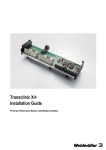
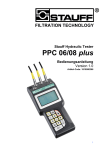
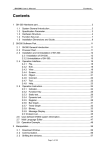


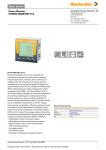
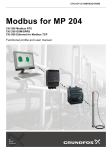

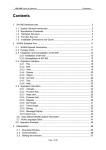
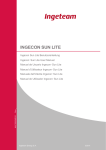
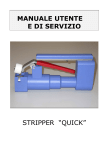
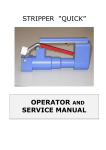
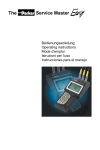
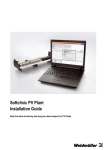
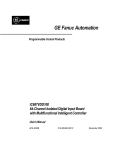
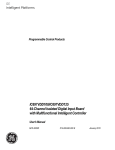
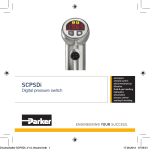
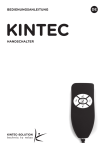
![Fronius String Control 125/25 [42,0410,1268]](http://vs1.manualzilla.com/store/data/006374199_1-8f1f21f20f580b642976bc9720b0b1fe-150x150.png)